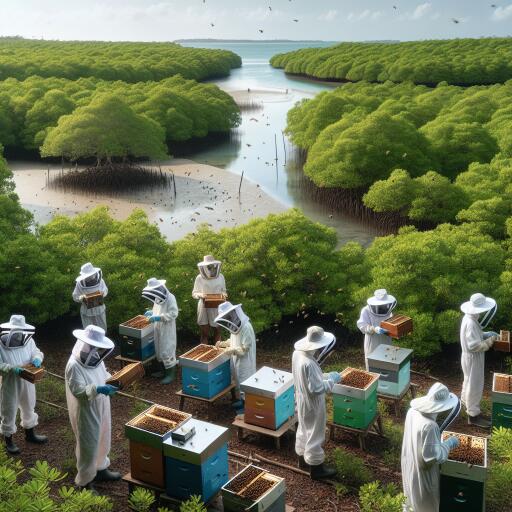
Beekeeping Helps Villagers Tend Coastal Forests in Thai Mangrove Hotspot
In a serene corner of southern Thailand’s Krabi province, nestled by the shimmering Andaman Sea, the small village of Ban Nai Nang is buzzing with activity far beyond its traditional fishing roots. Here, amidst a labyrinth of mangrove forests that line the turquoise backwaters, a unique conservation effort is unfolding, spearheaded by the village’s industrious inhabitants and their tiny, tireless allies: bees.
Ali Madwang, a key figure in Ban Nai Nang’s community enterprise, gently lifts the lid off a wooden bee box, revealing a busy hive inside. Sunlight streams in, catching the intricate dance of bees as they nurture their home, a hive buzzing with life and dripping with honey. Madwang, who has overseen the village’s journey towards integrating beekeeping with environmental conservation, shares, “These bees are not just producing honey; they are a testament to the power of communal living and mutual care within nature.”
This initiative, transcending merely a source of income through honey production, serves a dual purpose: it enhances the villagers’ livelihoods while promoting the regeneration and conservation of the surrounding mangrove forests. The mangroves, vital for local biodiversity and a buffer against climate change, provide a rich habitat for numerous species, including otters and marine turtles, while also being essential for artisanal fisheries.
More than 600 hectares of lush mangrove forests are collectively managed and protected by the villagers, integrating traditional livelihoods of fishing and small-scale agriculture with innovative approaches to environmental stewardship. The inception of beekeeping in Ban Nai Nang was championed by the collaboration between the villagers and conservationists, recognizing the mutual benefit for both the environment and the community.
The endeavor has far-reaching impacts, from enhancing mangrove pollination—thereby supporting the ecosystem’s natural regeneration—to offering alternative income sources to local families through the sale of honey and bee-related products. This model has not only bolstered the resilience of the mangrove ecosystems but has also fostered a sustainable economic pathway for the community.
Ban Nai Nang’s approach to conservation through beekeeping is part of a broader trend across Thailand, where communities are increasingly turning to innovative, nature-based solutions to protect their ecosystems while sustaining their livelihoods. These grassroots efforts complement more formal conservation strategies and highlight the critical role of local knowledge and engagement in environmental preservation.
The village’s success is underscored by the broader recognition of the importance of mangroves, which serve as critical coastal defenses, carbon sinks, and nurseries for marine life. Efforts to restore and protect these vital ecosystems have gained momentum in recent years, with communities like Ban Nai Nang leading the way through initiatives that are rooted in local culture and traditions yet innovative in their approach to sustainability.
Suthee Pankawan, another local leader, reflects on the journey toward mangrove restoration following the devastation of earlier decades. “The transformation we see today, from dwindling forests to thriving ecosystems, is a testament to the community’s resilience and dedication to conservation,” he remarks. “Beekeeping has been a catalyst, intertwining our livelihoods with the health of the environment, showing us the way toward a sustainable future.”
The villagers’ efforts have extended beyond their own community, with training programs for other villages looking to replicate this model of conservation and livelihood enhancement. The success of Ban Nai Nang’s model lies in its simplicity and the tangible benefits it brings to both the natural environment and the people who depend on it.
As the community looks to the future, their focus remains on expanding the reach of their conservation efforts, exploring new avenues to enhance the biodiversity of their mangrove forests, and ensuring that the delicate balance between human needs and environmental sustainability is maintained.
In Ban Nai Nang, the buzz of bees is the sound of hope, a reminder of the resilience of nature, and the possibilities that emerge when communities come together to protect and nurture their natural heritage.





Leave a Reply